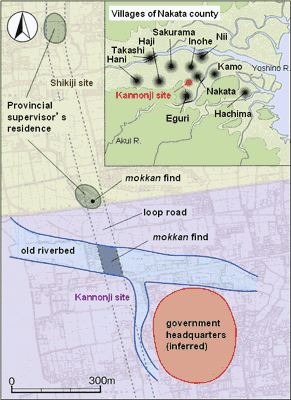Kannonji/Shikiji:
For the first time, other than the Shōsōin documents. A mokkan (wooden document) telling the actual state of kanjaku (an inquiry into personal identity) is recovered.

Wooden document recording ōnie (a tax in kind)
|

Wooden document bearing a dated inscription
|

Wooden document from the Shikiji site
|

A kanjaku wooden document
|


Human effigy made of wood

Boat effigies made of wood Both ends of a log are cut diagonally as the bow and stern, and a portion on the top may be left and trimmed as a box-shaped cabin. These items are thought to have been used together with human effigies in the harae purification rite. The one on the right is 25.8 cm in length. | |


A bronze seal
| |

Map of the positional relations of the sites
Kannonji and Shikiji Sites, Tokushima City, Tokushima Prefecture
These sites, located at an elevation of 7 – 8 m atop an alluvial fan made by the Akui river, a branch of the Yoshino river flowing into the Kii straits at the eastern end of Shikoku, are related to the government headquarters for the ancient province of Awa. This area was previously known as the presumed location of the provincial government headquarters, but the actual location of buildings such as the provincial government office, central to the headquarters, had been unknown.
At the Kannonji site, where investigation began in 1996 in conjunction with road construction, the traces of two old rivers from the Nara period were discovered, flowing across the western and northern sides of the presumed area of the government headquarters district. Large numbers of artifacts, including pottery and wooden implements, were discovered in these old riverbeds. Of particular note are the approximately 200 mokkan (wooden documents) that were recovered, dating from the mid-seventh to the tenth centuries, beginning with a kanjaku document used for a Nara period inquiry into someone’s family registry.
What was learned from the recovered wooden documents
Kanjaku refers to the confirmation of the age and address of a person, who has been appointed as a bureaucrat at the capital, through an inquiry to his place of origin. This type of inquiry into personal identity has been seen in the records surviving at the Shōsōin, but this is the first example of one written on a mokkan. Other wooden documents recovered include items bearing the dates of 689 (recorded in the Chinese sexagenary cycle) and 750 (recorded as the second year of the Tenpyō Shōhō era), and many giving place names within the ancient province of Awa as well as personal names, plus articles that were paid as tax, and hence are thought to have been used within government offices. From this it now appears certain that the provincial government office of Awa was located somewhere adjacent to the Kannonji site.
In addition to mokkan, wooden items for use in ritual and other wooden implements were recovered in large numbers, providing valuable materials for learning about the nature of the provincial headquarters at the time.
The Shikiji site indicates the extent of the provincial headquarters district
At the Shikiji site, adjacent to Kannonji on its north, buildings thought to have been part of the provincial supervisor’s residence from the first half of the eighth to the ninth centuries have been identified. Three embedded-pillar buildings were seen to have been placed in a U-shaped arrangement, and then rebuilt in almost precisely the same positions. A well was also dug on the premises, from within which numerous wooden documents and ritual implements were recovered. Ritual items and mokkan were also uncovered in large numbers from an old riverbed near the buildings.
The extent of the provincial headquarters was previously thought to have been concentrated on the vicinity of the slight elevation in the area around the Kannonji site, but it has now become clear that it spread further to the north. (Ōhashi Yasunobu)
